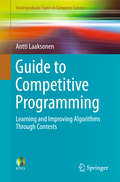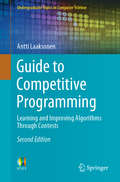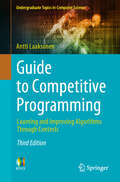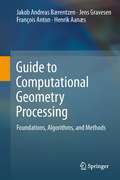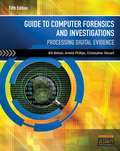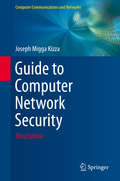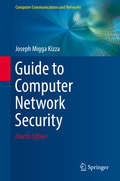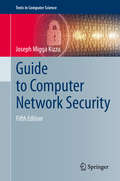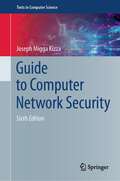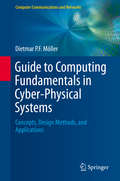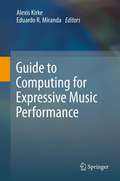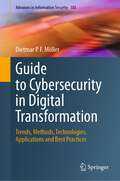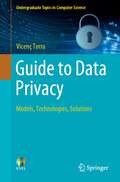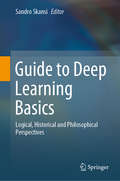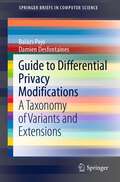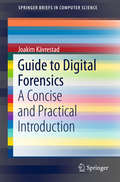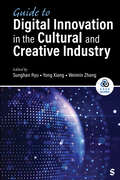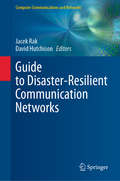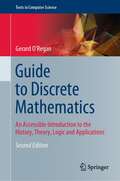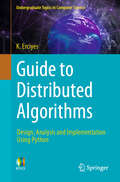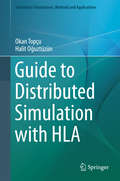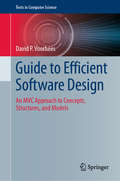- Table View
- List View
Guide to Competitive Programming
by Antti LaaksonenThis invaluable textbook presents a comprehensive introduction to modern competitive programming. The text highlights how competitive programming has proven to be an excellent way to learn algorithms, by encouraging the design of algorithms that actually work, stimulating the improvement of programming and debugging skills, and reinforcing the type of thinking required to solve problems in a competitive setting. The book contains many "folklore" algorithm design tricks that are known by experienced competitive programmers, yet which have previously only been formally discussed in online forums and blog posts. Topics and features: reviews the features of the C++ programming language, and describes how to create efficient algorithms that can quickly process large data sets; discusses sorting algorithms and binary search, and examines a selection of data structures of the C++ standard library; introduces the algorithm design technique of dynamic programming, and investigates elementary graph algorithms; covers such advanced algorithm design topics as bit-parallelism and amortized analysis, and presents a focus on efficiently processing array range queries; surveys specialized algorithms for trees, and discusses the mathematical topics that are relevant in competitive programming; examines advanced graph techniques, geometric algorithms, and string techniques; describes a selection of more advanced topics, including square root algorithms and dynamic programming optimization. This easy-to-follow guide is an ideal reference for all students wishing to learn algorithms, and practice for programming contests. Knowledge of the basics of programming is assumed, but previous background in algorithm design or programming contests is not necessary. Due to the broad range of topics covered at various levels of difficulty, this book is suitable for both beginners and more experienced readers. <P><P><i>Advisory: Bookshare has learned that this book offers only partial accessibility. We have kept it in the collection because it is useful for some of our members. To explore further access options with us, please contact us through the Book Quality link on the right sidebar. Benetech is actively working on projects to improve accessibility issues such as these.</i>
Guide to Competitive Programming: Learning and Improving Algorithms Through Contests (Undergraduate Topics in Computer Science)
by Antti LaaksonenBuilding on what already is the most comprehensive introduction to competitive programming, this enhanced new textbook features new material on advanced topics, such as calculating Fourier transforms, finding minimum cost flows in graphs, and using automata in string problems. Critically, the text accessibly describes and shows how competitive programming is a proven method of implementing and testing algorithms, as well as developing computational thinking and improving both programming and debugging skills.Topics and features: introduces dynamic programming and other fundamental algorithm design techniques, and investigates a wide selection of graph algorithms; compatible with the IOI Syllabus, yet also covering more advanced topics, such as maximum flows, Nim theory, and suffix structures; surveys specialized algorithms for trees, and discusses the mathematical topics that are relevant in competitive programming; reviews the features of the C++ programming language, and describes how to create efficient algorithms that can quickly process large data sets; discusses sorting algorithms and binary search, and examines a selection of data structures of the C++ standard library; covers such advanced algorithm design topics as bit-parallelism and amortized analysis, and presents a focus on efficiently processing array range queries; describes a selection of more advanced topics, including square-root algorithms and dynamic programming optimization.Fully updated, expanded and easy to follow, this core textbook/guide is an ideal reference for all students needing to learn algorithms and to practice for programming contests. Knowledge of programming basics is assumed, but previous background in algorithm design or programming contests is not necessary. With its breadth of topics, examples and references, the book is eminently suitable for both beginners and more experienced readers alike.
Guide to Competitive Programming: Learning and Improving Algorithms Through Contests (Undergraduate Topics in Computer Science)
by Antti LaaksonenThis textbook features new material on advanced topics, such as calculating Fourier transforms, finding minimum cost flows in graphs, and using automata in string problems. Critically, the text accessibly describes and shows how competitive programming is a proven method of implementing and testing algorithms, as well as developing computational thinking and improving both programming and debugging skills. Topics and features: Introduces dynamic programming and other fundamental algorithm design techniques, and investigates a wide selection of graph algorithms Compatible with the IOI Syllabus, yet also covering more advanced topics, such as maximum flows, Nim theory, and suffix structures Provides advice for students aiming for the IOI contest Surveys specialized algorithms for trees, and discusses the mathematical topics that are relevant in competitive programming Examines the use of the Python language in competitive programming Discusses sorting algorithms and binary search, and examines a selection of data structures of the C++ standard library Explores how GenAI will impact on the future of the field Covers such advanced algorithm design topics as bit-parallelism and amortized analysis, and presents a focus on efficiently processing array range queries Describes a selection of more advanced topics, including square-root algorithms and dynamic programming optimization Fully updated, expanded and easy to follow, this core textbook/guide is an ideal reference for all students needing to learn algorithms and to practice for programming contests. Knowledge of programming basics is assumed, but previous background in algorithm design or programming contests is not necessary. With its breadth of topics, examples and references, the book is eminently suitable for both beginners and more experienced readers alike.
Guide to Computational Geometry Processing
by Jens Gravesen J. Andreas Bærentzen François Anton Henrik AanæsThis book reviews the algorithms for processing geometric data, with a practical focus on important techniques not covered by traditional courses on computer vision and computer graphics. Features: presents an overview of the underlying mathematical theory, covering vector spaces, metric space, affine spaces, differential geometry, and finite difference methods for derivatives and differential equations; reviews geometry representations, including polygonal meshes, splines, and subdivision surfaces; examines techniques for computing curvature from polygonal meshes; describes algorithms for mesh smoothing, mesh parametrization, and mesh optimization and simplification; discusses point location databases and convex hulls of point sets; investigates the reconstruction of triangle meshes from point clouds, including methods for registration of point clouds and surface reconstruction; provides additional material at a supplementary website; includes self-study exercises throughout the text.
Guide to Computer Forensics and Investigations: Processing Digital Evidence
by Amelia Phillips Bill Nelson Christopher SteuartUpdated with the latest advances from the field, GUIDE TO COMPUTER FORENSICS AND INVESTIGATIONS, Fifth Edition combines all-encompassing topic coverage, authoritative information from seasoned experts, and real-world applications to deliver the most comprehensive forensics resource available. This proven author team's wide ranging areas of expertise mirror the breadth of coverage provided in the book, which focuses on techniques and practices for gathering and analyzing evidence used to solve crimes involving computers. While other books offer more of an overview of the field, this hands-on learning text provides clear instruction on the tools and techniques of the trade, introducing readers to every step of the computer forensics investigation-from lab set-up to testifying in court. It also details step-by-step guidance on how to use current forensics software and provides free demo downloads. Appropriate for learners new to the field, it is also an excellent refresher and technology update for professionals in law enforcement, investigations, or computer security.
Guide to Computer Network Security
by Joseph Migga KizzaThis comprehensive guide exposes the security risks and vulnerabilities of computer networks and networked devices, offering advice on developing improved algorithms and best practices for enhancing system security. Fully revised and updated, this new edition embraces a broader view of computer networks that encompasses agile mobile systems and social networks. Features: provides supporting material for lecturers and students, including an instructor's manual, slides, solutions, and laboratory materials; includes both quick and more thought-provoking exercises at the end of each chapter; devotes an entire chapter to laboratory exercises; discusses flaws and vulnerabilities in computer network infrastructures and protocols; proposes practical and efficient solutions to security issues; explores the role of legislation, regulation, and law enforcement in maintaining computer and computer network security; examines the impact of developments in virtualization, cloud computing, and mobile systems.
Guide to Computer Network Security
by Joseph Migga KizzaWith the growth of cloud computing, social networks, and ever more advanced mobile devices, information security and assurance has become more important than ever before. This comprehensive and authoritative "Guide to Computer Network Security" exposes the various security risks and vulnerabilities of computer networks and networked devices, offering advice on developing improved algorithms and best practices for enhancing system security. Fully revised and updated, this much-anticipated new edition embraces a broader view of computer networks that encompasses new agile mobile systems and social networks. The book broadly surveys thought-provoking security issues, discussing and raising questions about the impact of new technologies and protocols. Topics and features: provides supporting material for lecturers and students at an associated website, including syllabus suggestions, an instructor s manual, slides, solutions, and laboratory materials; includes both quickly-workable questions and more thought-provoking advanced exercises at the end of each chapter; devotes an entire chapter to laboratory exercises, offering both weekly and semester-long assignments, and hard open research projects; surveys known security threats, and discusses flaws and vulnerabilities in computer network infrastructures and protocols; reviews existing best practices, proposes practical and efficient solutions to security issues, and encourages readers to investigate alternative possible approaches; explores the role of legislation, regulation, and law enforcement in maintaining computer and computer network security; examines the impact of developments in virtualization, cloud computing, and mobile systems, which have extended the boundaries of the traditional computer network. This unique text/reference is an essential instructional and research tool for undergraduates in computer science and engineering. It is also a valuable reference for practitioners involved in computer networks, data security, and information-intensive areas. "
Guide to Computer Network Security (Computer Communications and Networks)
by Joseph Migga KizzaThis fully updated new edition explores the security issues, vulnerabilities and dangers encountered by the users of modern computing and communication devices, highlighting the need to develop improved algorithms, protocols, and best practices to enhance the security of public, private and enterprise systems alike. Features: introduces the fundamentals of traditional computer networks and the security threats they face; discusses the security challenges introduced by virtualization software, cloud computing and mobile systems; examines the security quagmire presented by the home computing environment; raises important legislative, legal, social, technical and ethical security issues, including the tension between the needs of individual privacy and collective security; provides both quickly workable and more thought-provoking exercises at the end of each chapter, with one chapter devoted entirely to lab exercises; supplies additional support material for instructors at an associated website.
Guide to Computer Network Security (Texts in Computer Science)
by Joseph Migga KizzaThis timely textbook presents a comprehensive guide to the core topics in cybersecurity, covering issues of security that extend beyond traditional computer networks to the ubiquitous mobile communications and online social networks that have become part of our daily lives. In the context of our growing dependence on an ever-changing digital ecosystem, this book stresses the importance of security awareness, whether in our homes, our businesses, or our public spaces.This fully updated new edition features new material on the security issues raised by blockchain technology, and its use in logistics, digital ledgers, payments systems, and digital contracts.Topics and features:Explores the full range of security risks and vulnerabilities in all connected digital systemsInspires debate over future developments and improvements necessary to enhance the security of personal, public, and private enterprise systemsRaises thought-provoking questions regarding legislative, legal, social, technical, and ethical challenges, such as the tension between privacy and securityDescribes the fundamentals of traditional computer network security, and common threats to securityReviews the current landscape of tools, algorithms, and professional best practices in use to maintain security of digital systemsDiscusses the security issues introduced by the latest generation of network technologies, including mobile systems, cloud computing, and blockchainPresents exercises of varying levels of difficulty at the end of each chapter, and concludes with a diverse selection of practical projectsOffers supplementary material for students and instructors at an associated website, including slides, additional projects, and syllabus suggestionsThis important textbook/reference is an invaluable resource for students of computer science, engineering, and information management, as well as for practitioners working in data- and information-intensive industries.
Guide to Computer Network Security (Texts in Computer Science)
by Joseph Migga KizzaThis timely textbook presents a comprehensive guide to the core topics in computing and information security and assurance realms, going beyond the security of networks to the ubiquitous mobile communications and online social networks that have become part of daily life.In the context of growing human dependence on a digital ecosystem, this book stresses the importance of security awareness—whether in homes, businesses, or public spaces. It also embraces the new and more agile and artificial-intelligence-boosted computing systems models, online social networks, and virtual platforms that are interweaving and fueling growth of an ecosystem of intelligent digital and associated social networks. This fully updated edition features new material on new and developing artificial intelligence models across all computing security systems spheres, blockchain technology, and the metaverse, leading toward security systems virtualizations.Topics and features:Explores the range of risks and vulnerabilities in all connected digital systemsPresents exercises of varying levels of difficulty at the end of each chapter, and concludes with a diverse selection of practical projectsDescribes the fundamentals of traditional computer network security, and common threats to securityDiscusses the role and challenges of artificial intelligence in advancing the security of computing systems’ algorithms, protocols, and best practicesRaises thought-provoking questions regarding legislative, legal, social, technical, and ethical challenges, such as the tension between privacy and securityOffers supplementary material for students and instructors at an associated website, including slides, additional projects, and syllabus suggestionsThis important textbook/reference is an invaluable resource for students of computer science, engineering, and information management, as well as for practitioners working in data- and information-intensive industries.Professor Joseph Migga Kizza is a professor, former Head of the Department of Computer Science and Engineering, and a former Director of the UTC InfoSec Center, at the University of Tennessee at Chattanooga, USA. He also authored the successful Springer textbooks Ethical and Social Issues in the Information Age and Ethical and Secure Computing: A Concise Module.
Guide to Computing Fundamentals in Cyber-Physical Systems
by Dietmar P. F. MöllerThis book presents an in-depth review of the state of the art ofcyber-physical systems (CPS) and their applications. Relevant case studies arealso provided, to help the reader to master the interdisciplinary material. Features: includes self-testexercises in each chapter, together with a glossary; offers a variety of teachingsupport materials at an associated website, including a comprehensive set ofslides and lecture videos; presents a brief overview of the study of systems,and embedded computing systems, before defining CPS; introduces the concepts ofthe Internet of Things, and ubiquitous (or pervasive) computing; reviews thedesign challenges of CPS, and their impact on systems and software engineering;describes the ideas behind Industry 4. 0 and the revolutions in digitalmanufacturing, including smart and agile manufacturing, as well ascybersecurity in manufacturing; considers the social impact of the changes inskills required by the globalized, digital work environment of the future.
Guide to Computing for Expressive Music Performance
by Eduardo R. Miranda Alexis KirkeThis book discusses all aspects of computing for expressive performance, from the history of CSEMPs to the very latest research, in addition to discussing the fundamental ideas, and key issues and directions for future research. Topics and features: includes review questions at the end of each chapter; presents a survey of systems for real-time interactive control of automatic expressive music performance, including simulated conducting systems; examines two systems in detail, YQX and IMAP, each providing an example of a very different approach; introduces techniques for synthesizing expressive non-piano performances; addresses the challenges found in polyphonic music expression, from a statistical modelling point of view; discusses the automated analysis of musical structure, and the evaluation of CSEMPs; describes the emerging field of embodied expressive musical performance, devoted to building robots that can expressively perform music with traditional instruments.
Guide to Cybersecurity in Digital Transformation: Trends, Methods, Technologies, Applications and Best Practices (Advances in Information Security #103)
by Dietmar P.F. MöllerIn today’s digital transformation environments, a rigorous cybersecurity approach to effective risk management — including contingency planning, outlining immediate actions, preparing post-breach responses — is central to defending organizations’ interconnected computer systems, networks, and infrastructure resources from malicious cyber-attacks.Specifically, cybersecurity technologies, processes, and practices need to be generalized and applied to intrusion detection and prevention measures. This entails analyzing profiles of cyber-attackers and building cyber-attack models for behavior simulation that can effectively counter such attacks. This comprehensive volume aims to cover all essential aspects of cybersecurity in digital transformation and to provide a framework for considering the many objectives and requirements involved. In addition to introducing theoretical foundations, the work also offers practical techniques for defending against malicious cybercriminals.Topics and features:Explores cybersecurity’s impact on the dynamics of interconnected, complex cyber- and physical systems, infrastructure resources, and networksProvides numerous examples of applications and best practicesConsiders methods that organizations can use to assess their cybersecurity awareness and/or strategyDescribes anomaly intrusion detection, a key tool in thwarting both malware and theft (whether by insiders or external parties) of corporate dataAddresses cyber-attacker profiles, cyber-attack models and simulation, cybersecurity ontology, access-control mechanisms, and policies for handling ransomware attacksDiscusses the NIST Cybersecurity Framework, MITRE Adversarial Tactics, Techniques and Common Knowledge, CIS Critical Security Controls, and the ISA/IEC 62442 Cybersecurity StandardGathering all the relevant information, this practical guide is eminently suitable as a self-study resource for engineers, scientists, computer scientists, and chief information officers. Further, with its many examples of best practices, it can serve as an excellent text for graduate-level courses and research into cybersecurity.Dietmar P. F. Möller, a retired full professor, is affiliated with the Institute for Mathematics at Clausthal University of Technology, Germany. He was an author of several other Springer titles, including Guide to Automotive Connectivity and Cybersecurity.
Guide to Data Privacy: Models, Technologies, Solutions (Undergraduate Topics in Computer Science)
by Vicenç TorraData privacy technologies are essential for implementing information systems with privacy by design.Privacy technologies clearly are needed for ensuring that data does not lead to disclosure, but also that statistics or even data-driven machine learning models do not lead to disclosure. For example, can a deep-learning model be attacked to discover that sensitive data has been used for its training? This accessible textbook presents privacy models, computational definitions of privacy, and methods to implement them. Additionally, the book explains and gives plentiful examples of how to implement—among other models—differential privacy, k-anonymity, and secure multiparty computation.Topics and features:Provides integrated presentation of data privacy (including tools from statistical disclosure control, privacy-preserving data mining, and privacy for communications)Discusses privacy requirements and tools for different types of scenarios, including privacy for data, for computations, and for usersOffers characterization of privacy models, comparing their differences, advantages, and disadvantagesDescribes some of the most relevant algorithms to implement privacy modelsIncludes examples of data protection mechanismsThis unique textbook/guide contains numerous examples and succinctly and comprehensively gathers the relevant information. As such, it will be eminently suitable for undergraduate and graduate students interested in data privacy, as well as professionals wanting a concise overview.Vicenç Torra is Professor with the Department of Computing Science at Umeå University, Umeå, Sweden.
Guide to Deep Learning Basics: Logical, Historical and Philosophical Perspectives
by Sandro SkansiThis stimulating text/reference presents a philosophical exploration of the conceptual foundations of deep learning, presenting enlightening perspectives that encompass such diverse disciplines as computer science, mathematics, logic, psychology, and cognitive science. The text also highlights select topics from the fascinating history of this exciting field, including the pioneering work of Rudolf Carnap, Warren McCulloch, Walter Pitts, Bulcsú László, and Geoffrey Hinton.Topics and features:Provides a brief history of mathematical logic, and discusses the critical role of philosophy, psychology, and neuroscience in the history of AIPresents a philosophical case for the use of fuzzy logic approaches in AIInvestigates the similarities and differences between the Word2vec word embedding algorithm, and the ideas of Wittgenstein and Firth on linguisticsExamines how developments in machine learning provide insights into the philosophical challenge of justifying inductive inferencesDebates, with reference to philosophical anthropology, whether an advanced general artificial intelligence might be considered as a living beingInvestigates the issue of computational complexity through deep-learning strategies for understanding AI-complete problems and developing strong AIExplores philosophical questions at the intersection of AI and transhumanismThis inspirational volume will rekindle a passion for deep learning in those already experienced in coding and studying this discipline, and provide a philosophical big-picture perspective for those new to the field.
Guide to Differential Privacy Modifications: A Taxonomy of Variants and Extensions (SpringerBriefs in Computer Science)
by Balázs Pejó Damien DesfontainesShortly after it was first introduced in 2006, differential privacy became the flagship data privacy definition. Since then, numerous variants and extensions were proposed to adapt it to different scenarios and attacker models. In this work, we propose a systematic taxonomy of these variants and extensions. We list all data privacy definitions based on differential privacy, and partition them into seven categories, depending on which aspect of the original definition is modified.These categories act like dimensions: Variants from the same category cannot be combined, but variants from different categories can be combined to form new definitions. We also establish a partial ordering of relative strength between these notions by summarizing existing results. Furthermore, we list which of these definitions satisfy some desirable properties, like composition, post-processing, and convexity by either providing a novel proof or collecting existing ones.
Guide to Digital Forensics
by Joakim KävrestadThis work introduces the reader to the world of digital forensics in a practical and accessible manner. The text was written to fulfill a need for a book that introduces forensic methodology and sound forensic thinking, combined with hands-on examples for common tasks in a computer forensic examination. The author has several years of experience as a computer forensics examiner and is now working as a university-level lecturer. Guide to Digital Forensics: A Concise and Practical Introduction is intended for students that are looking for an introduction to computer forensics and can also be used as a collection of instructions for practitioners. The aim is to describe and explain the steps taken during a forensic examination, with the intent of making the reader aware of the constraints and considerations that apply during a forensic examination in law enforcement and in the private sector. Upon reading this book, the reader should have a proper overview of the field of digital forensics, starting them on the journey of becoming a computer forensics expert.
Guide to Digital Innovation in the Cultural and Creative Industry (SAGE Works)
by Yong Xiang Sunghan Ryu Weimin ZhangThe digital age has brought significant changes to the cultural and creative industries, making it challenging to keep up with the latest trends. The Guide to Digital Innovation in the Cultural and Creative Industry is an informative resource that can help you navigate the revolution. It not only provides a comprehensive understanding of how digital transformation affects existing industries but also outlines emerging business opportunities. Whether you′re an experienced professional or a beginner, this book is an essential resource that will equip you with the knowledge and tools you need to succeed in the rapidly evolving landscape of the cultural and creative industries. Dive into: Democratizing creation: Discover how digital tools break down barriers and empower creators of all levels. From platforms to possibilities: Explore online video streaming, ebook publishing, virtual museums, and more, witnessing the rise of innovative business models. Cutting-edge tech, boundless potential: Delve into AI, blockchain, VR/AR, and other emerging technologies, understanding how they reshape content production, distribution, and consumption. Case studies that examine real-world scenarios, from the digital subscriptions of the New York Times to music consumption in the Spotify era.
Guide to Digital Innovation in the Cultural and Creative Industry (SAGE Works)
by Yong Xiang Sunghan Ryu Weimin ZhangThe digital age has brought significant changes to the cultural and creative industries, making it challenging to keep up with the latest trends. The Guide to Digital Innovation in the Cultural and Creative Industry is an informative resource that can help you navigate the revolution. It not only provides a comprehensive understanding of how digital transformation affects existing industries but also outlines emerging business opportunities. Whether you′re an experienced professional or a beginner, this book is an essential resource that will equip you with the knowledge and tools you need to succeed in the rapidly evolving landscape of the cultural and creative industries. Dive into: Democratizing creation: Discover how digital tools break down barriers and empower creators of all levels. From platforms to possibilities: Explore online video streaming, ebook publishing, virtual museums, and more, witnessing the rise of innovative business models. Cutting-edge tech, boundless potential: Delve into AI, blockchain, VR/AR, and other emerging technologies, understanding how they reshape content production, distribution, and consumption. Case studies that examine real-world scenarios, from the digital subscriptions of the New York Times to music consumption in the Spotify era.
Guide to Disaster-Resilient Communication Networks (Computer Communications and Networks)
by Jacek Rak David HutchisonThis authoritative volume presents a comprehensive guide to the evaluation and design of networked systems with improved disaster resilience. The text offers enlightening perspectives on issues relating to all major failure scenarios, including natural disasters, disruptions caused by adverse weather conditions, massive technology-related failures, and malicious human activities.Topics and features: describes methods and models for the analysis and evaluation of disaster-resilient communication networks; examines techniques for the design and enhancement of disaster-resilient systems; provides a range of schemes and algorithms for resilient systems; reviews various advanced topics relating to resilient communication systems; presents insights from an international selection of more than 100 expert researchers working across the academic, industrial, and governmental sectors.This practically-focused monograph, providing invaluable support on topics of resilient networking equipment and software, is an essential reference for network professionals including network and networked systems operators, networking equipment vendors, providers of essential services, and regulators. The work can also serve as a supplementary textbook for graduate and PhD courses on networked systems resilience.
Guide to Discrete Mathematics: An Accessible Introduction to the History, Theory, Logic and Applications (Texts in Computer Science)
by Gerard O'ReganThis stimulating textbook presents a broad and accessible guide to the fundamentals of discrete mathematics, highlighting how the techniques may be applied to various exciting areas in computing. The text is designed to motivate and inspire the reader, encouraging further study in this important skill. Features: This book provides an introduction to the building blocks of discrete mathematics, including sets, relations and functions; describes the basics of number theory, the techniques of induction and recursion, and the applications of mathematical sequences, series, permutations, and combinations; presents the essentials of algebra; explains the fundamentals of automata theory, matrices, graph theory, cryptography, coding theory, language theory, and the concepts of computability and decidability; reviews the history of logic, discussing propositional and predicate logic, as well as advanced topics such as the nature of theorem proving; examines the field of software engineering, including software reliability and dependability and describes formal methods; investigates probability and statistics and presents an overview of operations research and financial mathematics.
Guide to Distributed Algorithms: Design, Analysis and Implementation Using Python (Undergraduate Topics in Computer Science)
by K. ErciyesThe study of distributed algorithms provides the needed background in many real-life applications, such as: distributed real-time systems, wireless sensor networks, mobile ad hoc networks and distributed databases. The main goal of Guide to Distributed Algorithms is to provide a detailed study of the design and analysis methods of distributed algorithms and to supply the implementations of most of the presented algorithms in Python language, which is the unique feature of the book not found in any other contemporary books on distributed computing. Topics and features: Presents comprehensive design methods for distributed algorithms Provides detailed analysis for the algorithms presented Uses graph templates to demonstrate the working of algorithms Provides working Python code for most of the algorithms presented This unique textbook/study manual can serve as a comprehensive manual of distributed algorithms for Computer Science and non-CS majors as well as practitioners of distributed algorithms in research projects.
Guide to Distributed Simulation with HLA
by Okan Topçu Halit OğuztüzünThis invaluable textbook/reference provides a hands-on guide to the application of good software development practices to the construction of distributed simulation systems, with a particular focus on High Level Architecture (HLA). Emphasizing a learning-by-doing approach supported by examples, the text offers practical advice on real-world development issues for all engineers and programmers entering the field.Topics and features: explains how to rapidly develop an HLA federation, offering an implemented sample for each service area of the HLA federate interface specification; describes this implementation using the freely available software tools SimGe and RACoN; provides numerous step-by-step examples, code snippets, and case studies, as well as links to downloadable sample source code; uses the Microsoft .NET platform and the C# programming language in all examples and case studies; includes review questions throughout the book for further study; examines not only federate application development, but also object model construction; discusses the employment of HLA in multi-agent simulations.Providing an accessible introduction and all-in-one resource for HLA-based distributed simulation development, this book is an essential guide for students and practitioners training in distributed simulation and distributed interactive simulation.
Guide to Dynamic Simulations of Rigid Bodies and Particle Systems
by Murilo G. CoutinhoThis book introduces the techniques needed to produce realistic simulations and animations of particle and rigid-body systems. The text focuses on both the theoretical and practical aspects of developing and implementing physically based dynamic-simulation engines. Each chapter examines numerous algorithms, describing their design and analysis in an accessible manner, without sacrificing depth of coverage or mathematical rigor. Features: examines the problem of computing an hierarchical representation of the geometric description of each simulated object, as well as the simulated world; discusses the use of discrete and continuous collision detection to handle thin or fast-moving objects; describes the computational techniques needed for determining all impulsive and contact forces between bodies with multiple simultaneous collisions and contacts; presents techniques that can be used to dynamically simulate articulated rigid bodies; concludes each chapter with exercises.
Guide to Efficient Software Design: An MVC Approach to Concepts, Structures, and Models (Texts in Computer Science)
by David P. VoorheesThis classroom-tested textbook presents an active-learning approach to the foundational concepts of software design. These concepts are then applied to a case study, and reinforced through practice exercises, with the option to follow either a structured design or object-oriented design paradigm. The text applies an incremental and iterative software development approach, emphasizing the use of design characteristics and modeling techniques as a way to represent higher levels of design abstraction, and promoting the model-view-controller (MVC) architecture.Topics and features: provides a case study to illustrate the various concepts discussed throughout the book, offering an in-depth look at the pros and cons of different software designs; includes discussion questions and hands-on exercises that extend the case study and apply the concepts to other problem domains; presents a review of program design fundamentals to reinforce understanding of the basic concepts; focuses on a bottom-up approach to describing software design concepts; introduces the characteristics of a good software design, emphasizing the model-view-controller as an underlying architectural principle; describes software design from both object-oriented and structured perspectives; examines additional topics on human-computer interaction design, quality assurance, secure design, design patterns, and persistent data storage design; discusses design concepts that may be applied to many types of software development projects; suggests a template for a software design document, and offers ideas for further learning.Students of computer science and software engineering will find this textbook to be indispensable for advanced undergraduate courses on programming and software design. Prior background knowledge and experience of programming is required, but familiarity in software design is not assumed.
